

 |
 |
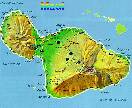
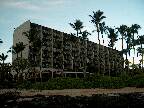
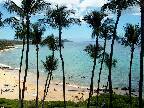 The Mana Kai (all pictures) is the name of the hotel
where we stayed in Maui. It is located on the south-west side of the
island, in South Kihei.
The Mana Kai (all pictures) is the name of the hotel
where we stayed in Maui. It is located on the south-west side of the
island, in South Kihei.
Our room had a great view of the beach and ocean. On the right of the beach was a lava flow-based reef which started right at the beach -- just walk into the water and enjoy the reef. |
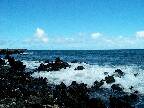
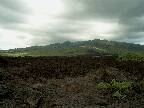 Perhaps 30 minutes further south from the hotel is Ahihi-Kina'u Natural Area
Reserve (all pictures). This is the location of
Maui's most recent lava flow, which took place in 1790. I made the trip to
La Perouse Bay within the Natural Area Reserve several times during our
stay, simply because the landscape fascinated me.
Perhaps 30 minutes further south from the hotel is Ahihi-Kina'u Natural Area
Reserve (all pictures). This is the location of
Maui's most recent lava flow, which took place in 1790. I made the trip to
La Perouse Bay within the Natural Area Reserve several times during our
stay, simply because the landscape fascinated me.
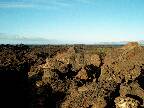
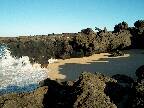 Quote:
Quote:
'Ahihi Cove is the first beach located inside the 'Ahihi-Kina'u Natural Area Reserve. It is a protected area and it is illegal to spear or capture fish in the reserve. There is no sand beach here, but the cove is protected from wind and surf and the snorkeling is usually terrific. This area is the site of the last lava flow on Maui in 1790. The lava covered everything as it poured down from Haleakala creating a surreal moonscape. |
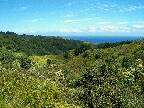
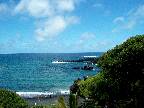 The road to Hana (all pictures) took us a full day to
explore. This trip covers the bottom half of the island of Maui, and it
took us through parts of the rain forest. The main goal was to reach the
Seven Sacred Pools (also known as O'heo Gulch) just a few miles past Hana,
but along the way we stopped to take many pictures, and I did get to jump
off some lava rocks into the ocean at Honokalani Black Sand Beach.
The road to Hana (all pictures) took us a full day to
explore. This trip covers the bottom half of the island of Maui, and it
took us through parts of the rain forest. The main goal was to reach the
Seven Sacred Pools (also known as O'heo Gulch) just a few miles past Hana,
but along the way we stopped to take many pictures, and I did get to jump
off some lava rocks into the ocean at Honokalani Black Sand Beach.

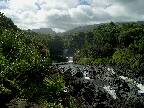 Quote:
Quote:
Honokalani Black Sand Beach is located in the Wainapanapa State Park. This large beach is set among lava cliffs and the sand is actually small, smooth, lava pebbles. A small sea arch, sea caves, and seaside lava tubes are located in the beach area. King's Highway, an ancient Hawaiian footpath, leads from the beach area along the coastline for 3 miles to the town of Hana. |
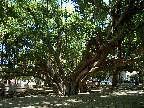
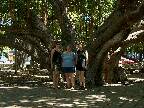 Lahaina (all pictures) is a small town on the North
side of the island. Of particular interest is a banyan tree with an
impressive display of aerial roots that covers most of a city block in front
of the historical Lahaina courthouse. Otherwise, Lahaina is more-or-less a
regular Maui tourist destination with many little shops.
Lahaina (all pictures) is a small town on the North
side of the island. Of particular interest is a banyan tree with an
impressive display of aerial roots that covers most of a city block in front
of the historical Lahaina courthouse. Otherwise, Lahaina is more-or-less a
regular Maui tourist destination with many little shops.
|

 On Monday August 16, Brendan and Stacey were married at the hotel where we
were staying. Congratulations, guys!
On Monday August 16, Brendan and Stacey were married at the hotel where we
were staying. Congratulations, guys!
I'll try to get my hands on a few more wedding pictures to post here (2004-Aug-30). It was a beautiful wedding, performed at sunset, just feet away from the beach. |
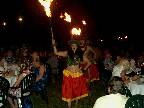
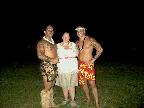 On Tuesday evening, we attended a traditional Hawaiian Luau. The night
started with drinks, a meal consisting primarily of a large pig wrapped in
banana leaves and roasted for many hours in a pit, followed by an
entertaining demonstration of many traditional Hawaiian and Polynesian
dances.
On Tuesday evening, we attended a traditional Hawaiian Luau. The night
started with drinks, a meal consisting primarily of a large pig wrapped in
banana leaves and roasted for many hours in a pit, followed by an
entertaining demonstration of many traditional Hawaiian and Polynesian
dances.
|
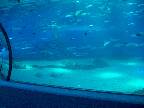
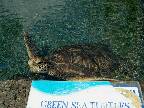 Kathie's choice of activity on our last day was to visit the aquarium
(all pictures) somewhere between Kahului and
Lahaina. The aquarium is actually a very nice facility. I especially
liked the clear, large underwater "tunnel" that you walk through with
almost 360° view of the ocean life.
Kathie's choice of activity on our last day was to visit the aquarium
(all pictures) somewhere between Kahului and
Lahaina. The aquarium is actually a very nice facility. I especially
liked the clear, large underwater "tunnel" that you walk through with
almost 360° view of the ocean life.
|
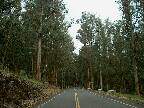
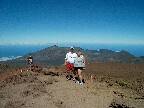 My own choice of activity to complete on our last day in Maui was a visit to
Haleakala National Park (all pictures), the volcano
that formed the south part of the island. The twisty road that leads up to
the summit of the volcano rises 10,000 feet in elevation from the ocean,
and took us through a thick layer of cloud, which can be clearly seen from
here for example.
My own choice of activity to complete on our last day in Maui was a visit to
Haleakala National Park (all pictures), the volcano
that formed the south part of the island. The twisty road that leads up to
the summit of the volcano rises 10,000 feet in elevation from the ocean,
and took us through a thick layer of cloud, which can be clearly seen from
here for example.
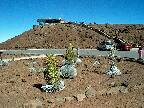
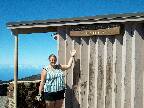 Quote:
Quote:
The 'ahinahina is a member of the sunflower family and is endemic to the upper slopes of the volcano above 6,500-foot elevation. |